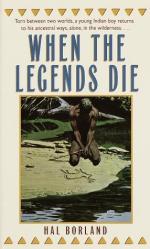|
This section contains 246 words (approx. 1 page at 400 words per page) |

|
Although not seen as a classic work of literature, Borland's examination of the effects of white culture on the life and psychology of a young Native American man has been used in studies of the problems of assimilation and culture clash in the United States. Recently, Borland's book became the focus of a study compiled by Dr. Mitch Holifield, a professor in the Department of Educational Administration and Secondary Education at Arkansas State University. In his article "When the Legends Die: A Point beyond Culture," published in Education, Holifield states that Borland's novel "realistically portrays the deculturalization of Native Americans." Holifield, using Edward T. Hall's Beyond Culture (1977), analyzes When the Legends Die, concluding that an understanding of this story and the effects upon the protagonist, Thomas Black Bull, could significantly change the way educators deal with the challenges of multiculturalism in American society. He writes, "Understanding...
|
This section contains 246 words (approx. 1 page at 400 words per page) |

|




